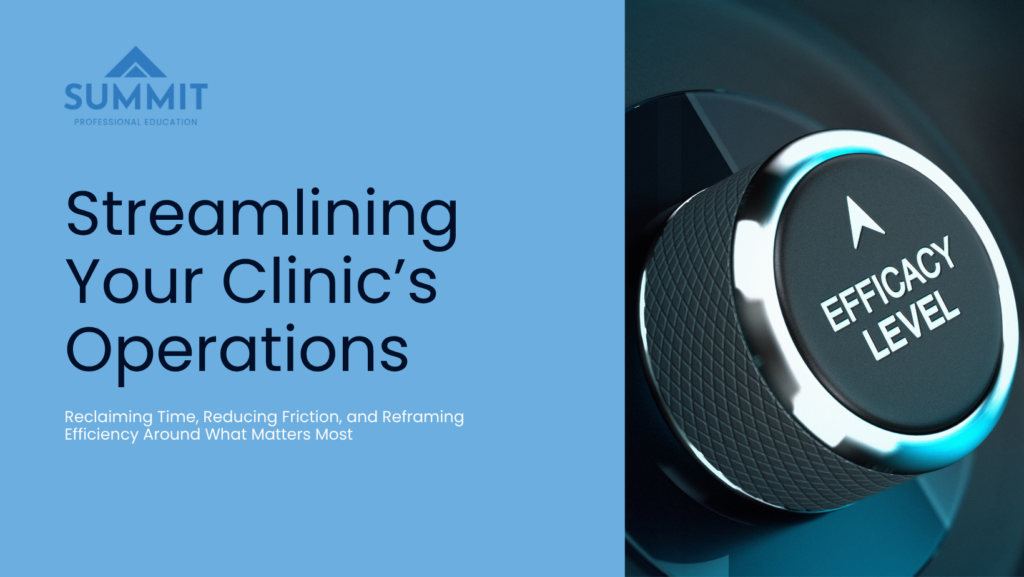Written by the Summit Professional Education Team, experts in continuing education for healthcare and allied professionals

Streamlining Your Clinic’s Operations for Maximum Efficiency
Efficiency is one of the most celebrated virtues in modern healthcare, often conflated with profitability, productivity, and progress. But in many outpatient therapy settings, this pursuit becomes a double-edged sword. As clinics push for leaner operations and faster throughput, the question emerges: efficient for whom? And at what cost?
This blog explores a contrarian yet increasingly necessary view—one that recognizes operational efficiency not as an end in itself, but as a means to support relationships, reduce clinician friction, and optimize care in ways that are humane, sustainable, and strategic.
The Cost of Speed
The prevailing model borrows heavily from industrial thinking. Identify bottlenecks. Eliminate redundancies. Increase volume. This approach might make sense in manufacturing—but the application to PT and OT practices is deeply flawed. Patients are not widgets. Clinicians are not machines. And value is not created through throughput alone.
Consider what happens when time per patient is reduced by five minutes. On a spreadsheet, it looks efficient. In practice, it often means rushed assessments, incomplete documentation, or superficial interactions that erode trust. Worse, it dehumanizes the experience for both therapist and patient—trading long-term therapeutic relationships for short-term task completion.
Clinics that chase speed for its own sake may find that what they gain in volume, they lose in outcomes, morale, and retention.
Redefining Efficiency: Time Well-Spent
Instead of measuring efficiency by time saved, high-performing clinics are starting to measure time *well-spent*. That means investing time where it matters most—on patient education, thoughtful documentation, meaningful mentorship, and team alignment.
This reframing encourages clinics to analyze not just workflows, but workflow *quality*. Where are staff losing time to confusion, ambiguity, or poor communication? Where are duplicative systems or outdated tools creating drag?
By addressing these root causes, practices can reclaim valuable time and reallocate it toward what actually drives results: clinical excellence, patient trust, and operational clarity.
Technology as a Multiplier—not a Replacement
Too often, technology is pitched as a way to reduce headcount or increase patient load. But technology that simply replaces human labor misses the point. The real opportunity lies in using digital tools to *amplify* human capability—not replace it.
The most successful PT/OT clinics are using technology to:
– Automate rote administrative tasks (scheduling, reminders, billing follow-ups)
– Streamline EMR workflows with intuitive templates and voice-to-text
– Enable asynchronous patient communication or digital home exercise plans
– Track performance metrics that inform staffing and scheduling decisions
Crucially, these tools are introduced with clinician input and refined over time. Efficiency gains are reinvested in development and patient care—not extracted as savings. This mindset shift ensures technology is in service to people, not the other way around.
Operational Leadership: Empowering the Frontline
Efficiency is rarely achieved through top-down mandates. It happens when frontline staff are empowered to identify friction points and co-design solutions. Yet in many clinics, therapists are expected to treat full caseloads *and* improve operations in their spare time.
That’s not just inefficient—it’s unsustainable.
Progressive clinics are creating dedicated roles or cross-functional committees focused on operations. These teams include clinicians, schedulers, and administrators who collaborate on continuous improvement. Whether through formal Kaizen cycles or informal weekly reviews, these forums create space to test, learn, and iterate.
They also reinforce a culture where every staff member sees themselves not just as a task-doer, but as a systems-thinker. That’s how you build a truly adaptive, efficient organization.
Linking Efficiency with Recruitment and Retention
An overlooked dimension of operational efficiency is its impact on talent. Burnout isn’t just emotional—it’s logistical. When clinicians spend hours chasing authorizations, navigating broken systems, or backfilling due to poor scheduling, they’re less likely to stay.
Operational clarity, on the other hand, breeds confidence. Clinicians who know what’s expected, how to execute, and where to find support are more productive and more fulfilled. This directly improves your Employer Value Proposition—and gives you a competitive edge in a tight labor market.
Additionally, efficient onboarding and consistent workflows reduce ramp-up time for new hires. Pair that with documented SOPs and digital onboarding tools, and you create a foundation for sustainable growth—without losing institutional knowledge.
Conclusion: The Human Side of Efficiency
Efficiency is not about doing more with less. It’s about doing the *right* things better—together.
PT and OT practices that prioritize operational excellence through a relationship-centered lens will find that efficiency does not have to come at the expense of empathy. With the right strategy, it becomes a pathway to it.
In this reimagined framework, efficiency means:
– Less friction, more focus
– Less churn, more continuity
– Less burnout, more belonging
When your operations reflect your values, your clinic becomes not just a well-oiled machine—but a well-loved place to heal, grow, and thrive.
Interested in Exploring Group Discounts? CLICK HERE
About Summit Professional Education
Summit equips Physical Therapists, Occupational Therapists and SLPs with better continuing education courses that provide CEUs while impacting patient outcomes. Find high-quality on-demand CE along with the largest offering of live options — including live webinars, live streams, and in-person courses. Want to deep dive on a topic? Summit offers hundreds of 6-hour courses for the most in-depth learning!
